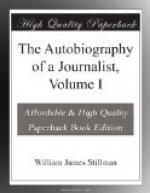Returning to Schenectady the following summer, I made my first direct and thorough studies from nature, and amongst these was one, a view from my window across gardens and a churchyard with the church spire in the distance; a small study which incidentally had a most potent effect on all my later life. It was bought in the autumn by the Art Union of New York, and on the proceeds, thirty dollars, the first considerable sum of money I had ever earned, I decided to go to Europe and see what the English painters were doing. Of English art I then knew only directly the pictures of Doughty, an early artistic immigrant from England, and, as afterwards appeared to me, a fair example of the school which had its lead from Constable, to whom he had, however, no resemblance except in choice of motive. He had a comprehension of technique possessed by none of our home painters—a rapid and masterly execution with a scale of color limited to cool grays, but, within this gamut, of exquisite refinement. Constant repetitions of the same motive wore out his welcome on the part of the American public, but his pictures had a charm which was long in losing its power over me, and had an influence in determining me to go to England at the first opportunity. But to see Turner’s pictures was always the chief motive, and was the one which decided me to go.
I was, in knowledge of worldly life, scarcely less a child then than I had been when, at the age of ten, I determined to go out into the world and make my own career, free from the obstacles I imagined to be preventing me from following my ideals. The ever-present feeling developed in me by the religious training of my mother, that an overruling Providence had my life in keeping, made me quite oblivious of or indifferent to the chances of disaster, for the assurance of protection and leading to the best end left no place for anxieties. It was a mental phenomenon which I now look back on with a wonder which I think most sane people will share, that, at the age when most boys have become men, for I graduated at twenty, I should have been capable of going out into a strange world like one of the children of the Children’s Crusade, with an unfaltering faith that I should be led and cared for by Providence as I had been by my




